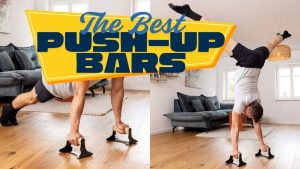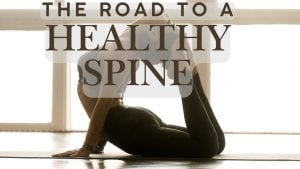The "Don't Climb That" Dilemma
If you’re reading this on Calisthenics.com, you probably already know the value of bodyweight training. You know the feeling of conquering your first pull-up, the stability of a handstand, or the raw functional strength that comes from manipulating your own body in space. But if you’re a parent, you also know the struggle of the modern world.
We live in a "No" environment. "Don't climb that," "Get down from there," "Sit still," "Stop jumping on the couch."
And then we hand them a tablet.
I’ve been training calisthenics for years, and the more I understand human biomechanics, the more I realize that toddlers and young children are the original calisthenics masters. Their strength-to-weight ratio is incredible. Their squat form is perfect. Their desire to hang, invert, and roll is innate. There
When we shut that down to keep them "safe" or "quiet," we aren't just stopping play; we are stunting physiological and neurological development.
I wanted to write this guide not just to give you a shopping list, but to help you change the architecture of your home. I want to help you build a "Yes" environment—a space where movement is the default, where "exercise" isn't a chore but a game, and where you can actually train alongside your kids.
Below, I’ve curated a list of equipment. Some of it is purely for the little ones, but a surprising amount of it is "dual-use"—gear that will help your child develop gross motor skills while giving you a station to grease the groove on your pull-ups or refine your L-sits.
But first, let’s look at the science, because as calisthenics athletes, we love knowing why we are doing what we’re doing.
The Theory: Why the Playground beats the iPad
You might think a jungle gym is just about burning off energy. It’s actually about building a brain.
There are two major sensory systems at play when a kid climbs a ladder or swings on a ring: the Vestibular System and Proprioception.
1. The Vestibular System (The Internal GPS)
Located in the inner ear, this system tells your brain where your head is in space. It handles balance and spatial orientation. A study published in the American Journal of Occupational Therapy highlights that vestibular input is crucial for posture, balance, and even gaze stabilization (which is necessary for reading later in life). When a kid spins, hangs upside down, or swings, they are calibrating this system.
2. Proprioception (Body Awareness)
This is the body's ability to sense movement, action, and location. It’s how you know where your hand is without looking at it. Heavy work—pushing, pulling, climbing—activates receptors in the joints and muscles.
3. The Necessity of "Risky Play"
Professor Ellen Sandseter of Queen Maud University College in Norway has done fascinating research on "risky play." Her papers suggest that children have a sensory need to taste fear and excitement. Climbing to heights or tumbling allows them to map their environment and learn risk assessment. If they don't do it in a safe, controlled environment (your living room gym), they might do it somewhere dangerous.
By bringing this equipment into your home, you aren't just buying toys. You are buying physical literacy.
PHASE 1: The Foundation (Toddlers & Preschoolers, Ages 2–6)
For this age group, the goal is Gross Motor Development. We want to encourage crawling, standing, cruising, and the beginnings of climbing. We are looking for stability and "open-ended play"—where the equipment can be a mountain one minute and a fort the next.
The "First Mountain"
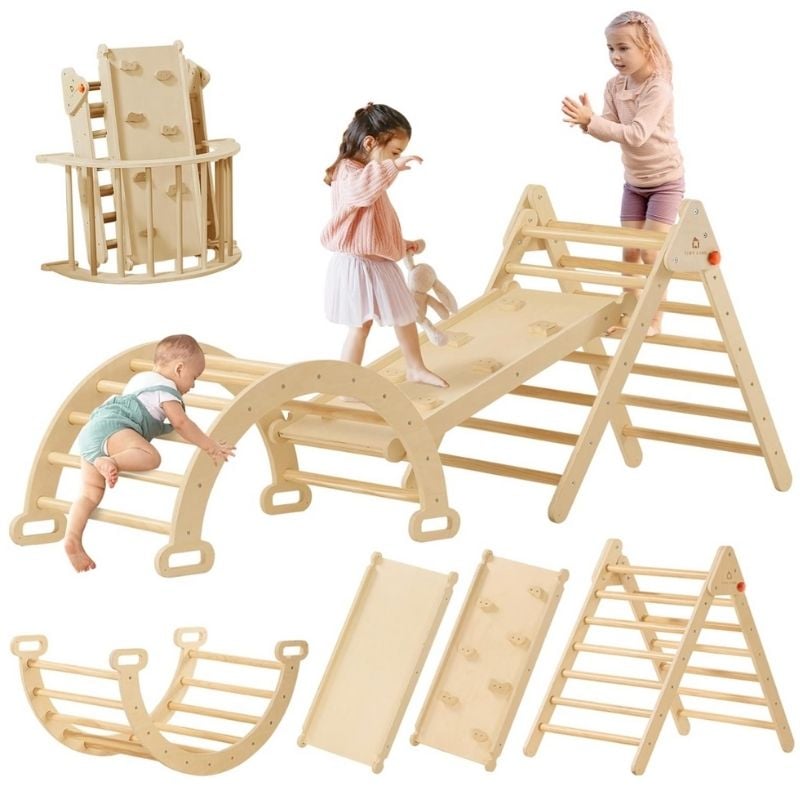
Tiny Land Foldable Pikler Triangle Climbing Toys Set
(Best for: Ages 1-4)
If you have a toddler, you’ve probably heard of Emmi Pikler. Her theory was simple: let the child develop movement at their own pace. This climbing triangle is the entry-level calisthenics station.
I love this specific set because it includes the ramp. A ramp is the precursor to walking on uneven terrain. What stands out to me about the Tiny Land set is the foldability. One of the biggest barriers to home gyms is space. Being able to fold this up and shove it under the couch when grandma visits is a huge plus.
- The Calisthenics Connection: It teaches the "three points of contact" rule for climbing before they are ever high enough to get hurt. It builds the foundational grip strength needed for monkey bars later.
The "Imagination Station"
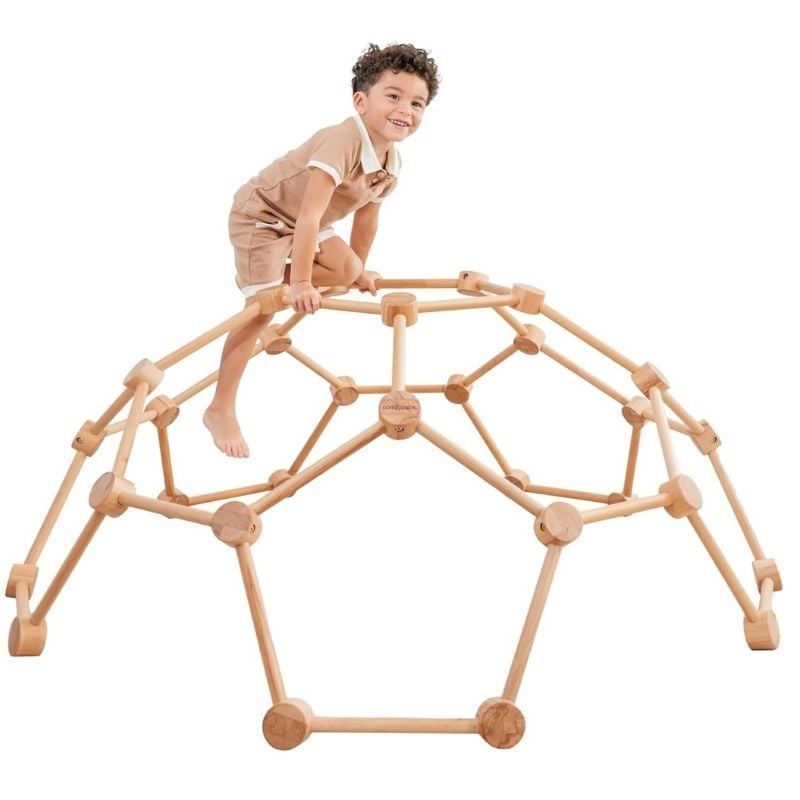
Comfy Cubs Wooden Toddler Play Gym (Climbing Dome)
(Best for: Ages 3-6)
This is a classic Montessori approach. It’s a dome, but throw a sheet over it and it’s a cave. The wooden construction is key here—it offers a tactile grip that plastic doesn't. Plastic can get slippery with sweat; wood absorbs a bit of moisture and provides better friction.
From a training perspective, a dome requires more complex route planning than a ladder. On a ladder, you go up. On a dome, you can go up, over, around, or through. This challenges a child's problem-solving skills and hip mobility in a way linear climbing doesn't.
The "All-in-One" Solution
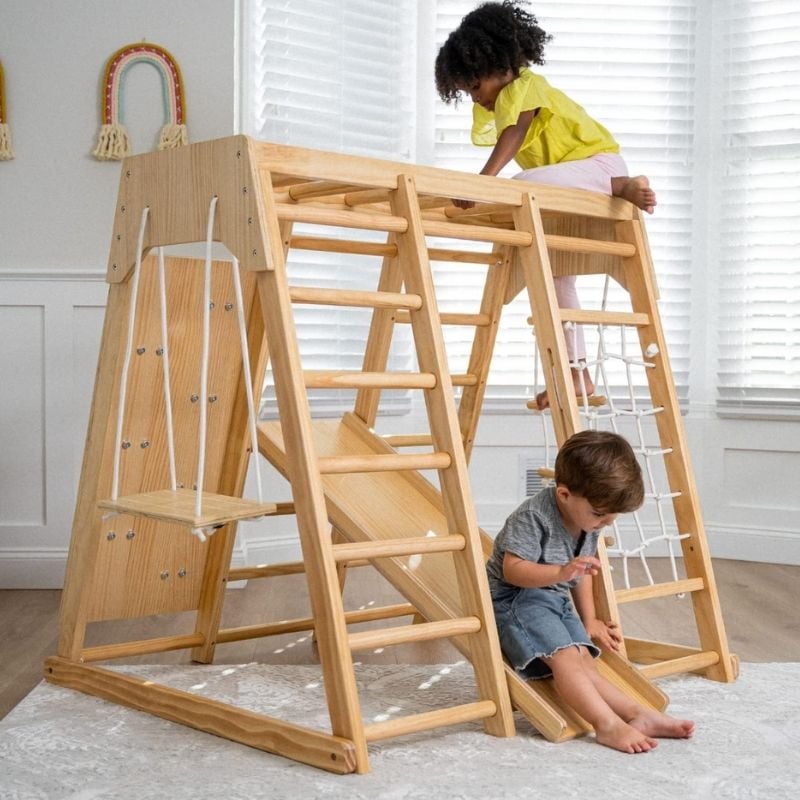
Avenlur Magnolia 7-in-1 Indoor Wooden Jungle Gym
(Best for: Ages 2-6)
If you have the floor space and you want to completely commit to the "Yes" environment, this is the gold standard for the under-6 crowd. It combines the slide, the rock wall, the monkey bars, and the swing.
Why do I recommend this? Because of the Monkey Bars. Brachiation (swinging from arm to arm) is one of the best things a human can do for shoulder health and spinal decompression. Most kids today lack the upper body strength to do a single pull-up. Getting them hanging on this set at age 3 or 4 sets them up for a lifetime of strong shoulders.
PHASE 2: The Skill Builders (School Age, Ages 4–12)
As the kids get older, the play needs to become more dynamic. We are moving from "stability" to "mobility" and "power." This is where we start introducing elements that mimic actual gymnastics and calisthenics training.
The "Doorway Dojo"
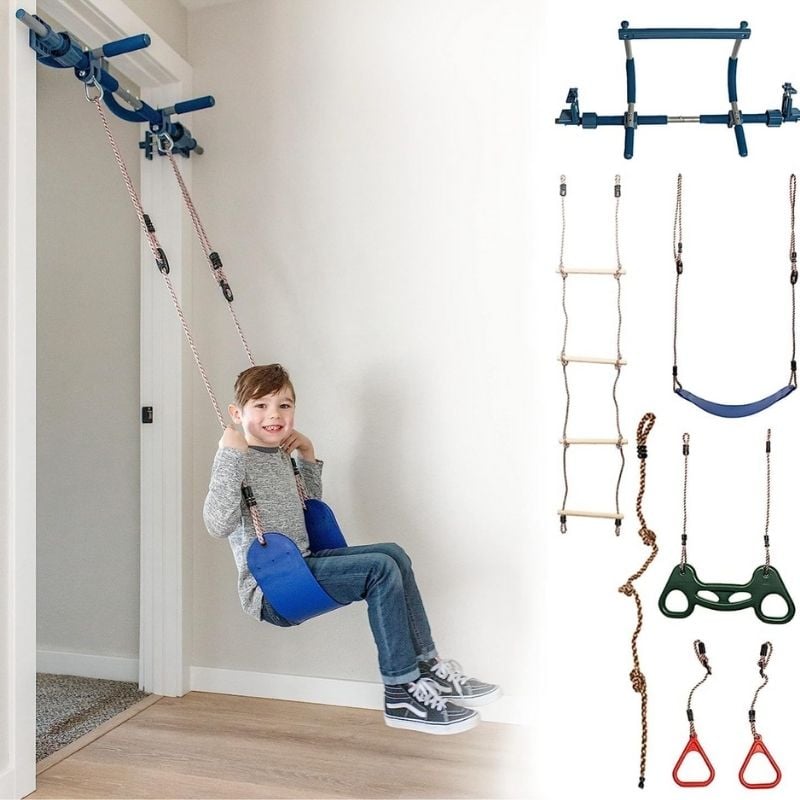
Doorway Gym Indoor Playground
(Best for: Ages 3-14 | Fits 25"-36" Doorways)
I cannot recommend this enough for people living in apartments or smaller homes. It utilizes the "dead space" of a doorway.
Here is the beauty of the Gym1: The Friction Mount. It uses a cantilever system (physics!) so you don't generally have to drill holes into your frame. It holds up to 300 lbs.
- Why it wins: It brings the playground inside. On a rainy Tuesday when the kids are bouncing off the walls, you hang the swing or the rope.
- Calisthenics Perspective: The rings and ladder attachments are fantastic for grip strength. You can challenge your kids to a "dead hang" competition. The winner picks the movie for the night.
The "Future Olympian" Setup
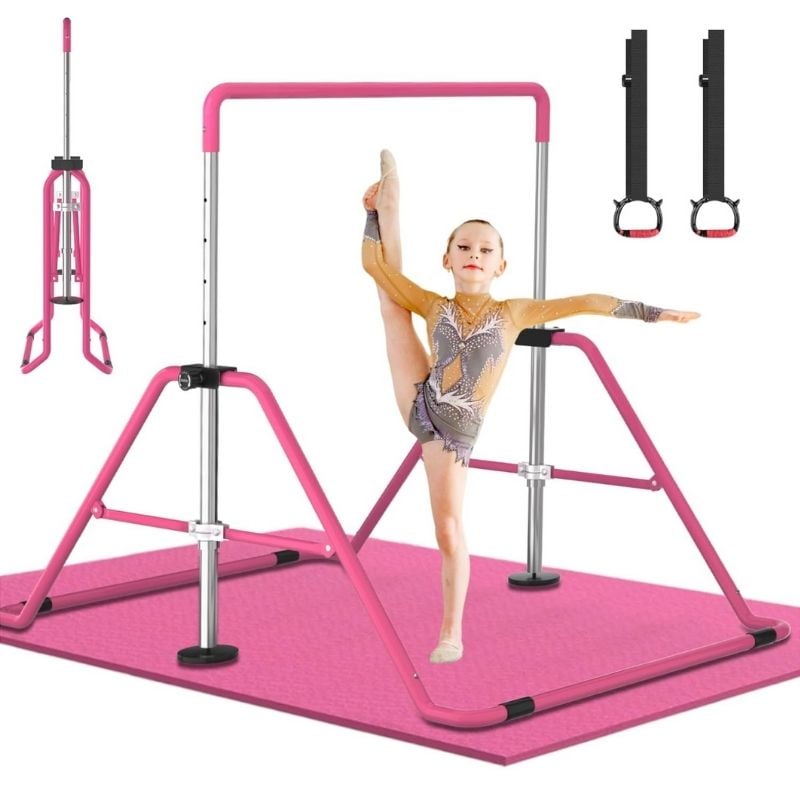
Kids Gymnastics Bar by DOBESTS
(Best for: Ages 3-7)
This is for the kid who is constantly trying to cartwheel in the kitchen. The triangle structure on the base is vital for stability—cheaper bars wobble, and wobbling kills confidence.
This bar adjusts up to 51 inches. This is where your child learns the Skin the Cat movement—a fundamental gymnastics move that stretches the shoulders and builds immense core strength. It comes with rings, which adds an instability element (excellent for stabilizer muscles), and a mat for safety.
The "Skill Acquisition" Mats
You cannot train fearlessly if you are afraid of the floor. You need mats. I recommend a two-part system here:

The Foundation: Folding Exercise Gymnastics Mat
This provides a 4x8 safe zone. High-density foam is important—you don't want squishy "sleeping" foam; you want firm, impact-absorbing foam.
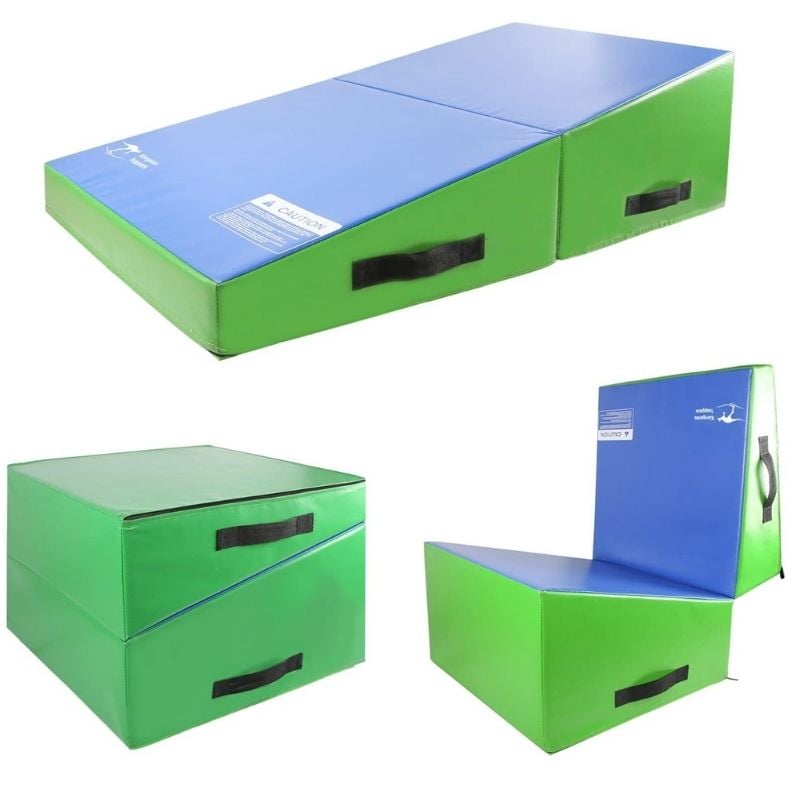
The Accelerator: Kangaroo Hoppers Incline Gymnastics Mat (Cheese Mat)
In the gymnastics world, we call this a "cheese mat." The incline is a cheat code for physics. It helps kids learn to roll (somersaults) by letting gravity do the work. It helps with backward rolls, and later, back handsprings.
- Creative Use: Flip it over to the "cube" shape and you have a plyometric box for box jumps. Now you’re training explosive leg power.
PHASE 3: The Hybrid "Family" Gear (Ages 4 to Adult)
This is my favorite category. This is the equipment that doesn't get thrown away when the kids grow up. This is the gear you will use after they go to bed.
The "Active Sitting" Hack

Active Seat Peanut Shaped Bounce Desk Chair
(Best for: High energy kids, Homework time)
Okay, it's not a "workout," but it is active recovery. If your kid struggles to sit still for homework, get this. The peanut shape is more stable than a round yoga ball (it only rolls one way), so they won't fall off, but they have to engage their core to stay upright.
- The Science: This is about "sensory seeking." Some kids wiggle because their brain is under-stimulated. The subtle bouncing wakes up the brain (alertness) without distracting them from the math problem.
The "Core Stabilizer"

Gentle Monster Wooden Wobble Balance Board
(Best for: Everyone)
This looks like a curved piece of wood. It is actually a deceptive piece of fitness equipment.
- For the Kid: It’s a bridge for cars, a cradle for dolls, or a slide from the sofa.
- For the Parent: Stand on it while watching TV. Rocking back and forth strengthens the ankles and knees (prehab for runners). Flip it over and use it for push-ups to add an instability challenge to your chest workout. It holds 480 lbs, so don't be shy.
The "Holy Grail" of Home Calisthenics
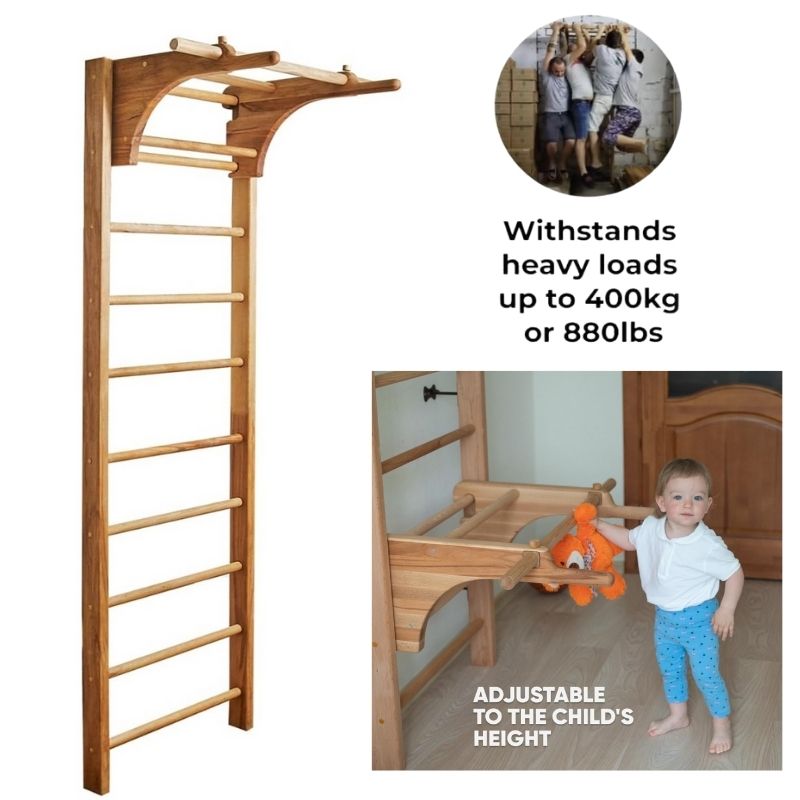
Swedish Ladder (Wall Bars)
(Best for: The Whole Family)
If you have a free wall stud, buy this. The Swedish Ladder (or Stall Bar) is the oldest and most effective piece of gymnastics equipment in existence.
- For the Kid: It’s a ladder to the ceiling. It’s a jungle gym that takes up zero floor space.
- For the Parent: This is your pull-up station. This is where you do Human Flags. This is where you do hanging leg raises for your abs. It supports 880 lbs (static load).
- Health Benefit: Simply hanging from the top bar for 60 seconds a day creates spinal decompression.6 After a long day of sitting at a desk or in a car, this is the best thing you can do for your back.
- The Feature: This specific model has a removable horizontal bar. You can lower it so your 5-year-old can do pull-ups, then move it to the top for your workout.
The "Gym in a Bag"

Kids Wooden Gymnastics Rings
(Best for: Outdoor/Indoor, Family)
I included "Kids" in the title, but check the specs: they hold 220 lbs. The ring diameter is slightly smaller (better for small hands), but most adults can use these comfortably too.
Rings are superior to bars because they move. Your body has to stabilize in 360 degrees.
- My advice: Take these to the park. Throw them over a sturdy tree branch or a soccer goal post. Adjust the height so they are low to the ground. Let your kids try to hold a "plank" on the rings, or do "ring rows." It’s the single best upper-body developer money can buy.
How to Introduce This Gear (Without Being Pushy)
As parents, we have a tendency to "over-coach." We buy the toy and immediately say, "Okay, do 5 reps!"
Don't do that.
The goal here is Autonomy.
- Set it up. Leave it alone.
- Use it yourself. Children mimic behavior. If they see you hanging from the Swedish Ladder or balancing on the Wobble Board, they will push you off so they can try.
- Create "The Floor is Lava" scenarios. Use the mats, the peanut ball, and the climbing dome to create an obstacle course. Time them. Then let them time you.
Conclusion: The Return on Investment
The toys listed above range from twenty bucks to a few hundred. But the ROI isn't measured in dollars.
It's measured in the bone density your child builds from impact loading (jumping).
It's measured in the confidence they gain when they finally conquer the top rung of the ladder.
It's measured in the connection you build when you are spotting them on their first backward roll on the cheese mat.
We are calisthenics athletes. We know that the body is the only machine we need. By gifting these tools to your children, you are teaching them that their body is capable, adaptable, and strong. You are giving them the tools to master their own gravity.
And honestly? It’s a lot more fun than watching Paw Patrol for the thousandth time.
What’s your first move?
If you’re overwhelmed by the list, start with the Doorway Gym or the Wobble Board. They are low-footprint, high-fun items that immediately change the dynamic of a room. Get them moving, and get moving with them.
Disclaimer: Always supervise children during play, especially with climbing equipment. Ensure all installations (like the Swedish Ladder and Doorway Gym) are secured into structural elements (studs/frames) according to the manufacturer's instructions.


